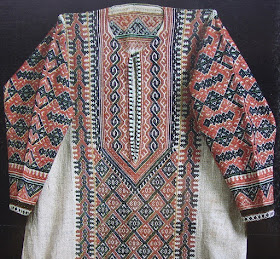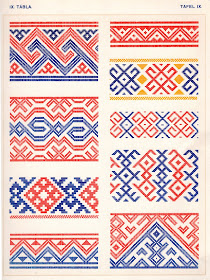Hello all,
I wrote on this subject a while ago, but I have found new information, and also I have realized that as I am not writing for an actual magazine, I do not need to keep my articles short. Thus I will expand on the subject today. I will present all of the images which I have found.
http://finugor.ru/en/southern-khanty-embroidery
The Khanty form part of the Ugric branch of the Uralic language family, together with the Mansi and the Hungarians. The Hungarians migrated to Europe many centuries ago, but their language is still most closely related to that of the Khanty and Mansi. On the following map, the Khanty are represented by the dark gray on the right side, east of the Urals, which officially puts them in Asia. You will notice a dotted area on the map that sort of approximates the territory of this people together with the Mansi, who are shown in light green. This area is known as the Khanty-Mansisk National District, and this is their flag.
In old documents the Khanty were known as the Ostyak and the Mansi were known as the Vogul.
The southern Khanty lived in the area surrounding the Konda and Demianka rivers, on either side of the Irtysh. This area lies on the border between the present day Khanty Mansi Okrug and Tiumen Oblast, and you will notice that it is not colored in the map above. This branch of the Khanty people have been completely assimilated today.
There are people today who are actively researching and reclaiming this heritage based on museum collections
.http://russiatrek.org/blog/culture/the-handicrafts-center-of-khantymansiysk-city/
Several of the first images show pure Russian costumes, but a couple show Khanty handwork
In the background you can see, from left to right, a woman's chemise, two men's shirts, a second woman's chemise with restricted embroidery, and a woman's outer garment which is open down the front, with another chemise underneath.. On the table in the foreground, you can see some South Khanty embroidery in progress.
This is one of the basic techniques of South Khanty embroidery, outline stitch. They also use brick or darning stitch and counted satin stitch to fill in areas defined by outline stitch.
Here are a couple of examples of Khanty embroidery which I found in Hungarian books.
Note that in this type of embroidery, one of the major motifs is a pair of birds facing each other.
As in many other cultures which use outline stitch to frame their motifs, here they love to put hooks and ornaments on the outlines.
Beadwork is also used,. directly on the garments and also on accessories.
The major garment for women is the chemise, which received the majority of the ornamentation.
A. Bogordaeva gives these various cuts along with zones of embroidery. These garments were primarily made of nettlecloth, while the embroidery was usually executed in wool. The garments are shown in pairs, first the front view, and below that, the rear.
Here are some closeups, showing the various types and layouts of embroidery used.
Here we see good examples of the darning stitch and brick stitch.
A few more garments showing a different embroidery technique.
Combinations of techniques are common.
The third major technique is just outline stitch by itself
I do not have any good quality images of this garment, but this is what I do have.
Men's shirts, and sometimes even pants, were also embroidered. Here are the cuts she gives for them.
The Southern Khanty embroidered pants are shown at the upper left, with the cut next to it. Plain pants of other cuts were also used.
There is a book which gathered many of these embroidery designs and graphed them in color.
I here present these plates. The original book gives the exact origin of each design. Some of these appear to use diagonal squares. These are actually executed on a diagonal.
The text follows, it is in both Hungarian and German. Click on these or any of these images to enlarge.
Thank you for reading. I hope that you have found this to be interesting and informative.
Take some of this embroidery and use it in your life. Art is something which belongs to all the world.
Roman K.
Rkozakand@aol.com
Source Material:
Natalia Kalashnikova 'National Costumes of the Soviet Peoples', Moscow, 1990
Mary Gostelow, 'The Complete International Book of Embroidery', New York, 1977
Ildiko Lehtinen, 'The Finno-Ugric Collections at the National Museum of Finland', no year
Zsigmund Batky, 'Osztyak Himzesek' [Ostyak Folk Embroidery], Budapest, 1921
Tatyana Razina, 'Folk Art in the Soviet Union', Leningrad, 1990
L. Molotova et al, 'Folk Art in the Russian Federation', Leningrad, 1981
Gyorgyi Lengyel, 'Keresztszemes Kezimunkak', Budapest, 1981
Gyorgyi Lengyel, 'Nagyaink Oroksege' Budapest, 1986
A. A. Bogordaeva, 'Traditsionnuj Kostium Obskykh Ugrov', Novosibirsk, 2006
Author and year unknown, 'Prilozhenie Narody Severa Sibiri v Kollektsiakh Omskogo Gosudarstvennogo Obiedinennogo Istoricheskogo i Literaturnogo Muzej/




































































































Thanks for expanding your article on Khanty embroidery. Their clothing is spectacular gracing everyday life with psychedelic stimulation. Gorgeous!
ReplyDelete